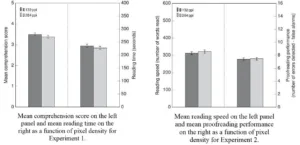A good deal of study was conducted during the 1980s and 1990s into the effects of pixel density on a variety of factors including visual performance, subjective well-being and preference. Most of these studies were conducted on CRT displays having a resolution in the range from about 60 ppi to 150 ppi. The studies determined that the effects on these factors were positive between 60 ppi and 150 ppi. Beyond 150 ppi, the benefits were less clear.

None-the-less, the pixel density of a modern TFT-LCD has advanced to achieving and even exceeding 264 ppi. Given this situation, a team of researchers headed by Susanne Mayr working within the Lehrstuhl für Psychologie mit Schwerpunkt Mensch-Maschine-Interaktion at the Universität Passau (Passau, Germany) has conducted a systematic investigation into the effects of high resolution displays on user performance and on measures of subjective well-being such as mood state and physical discomfort.
A recent article authored by the team is entitled “Effects of high pixel density on reading comprehension, proofreading performance, mood state, and physical discomfort.” It is scheduled for publication in Displays 48 (2017) 41-49. A copy of the article is available for purchase here.
A great deal of information on the experimental methods and the results is available in the article. Here is a brief summary of the most important results.
This article reports on two experiments conducted to test whether there are any measurable benefits of high pixel density (264 ppi) displays over low pixel density (132 ppi) displays.
In Experiment 1, participants’ performed a reading comprehension task on a display with either high or low pixel density. The result was that no differences were found in reading comprehension and reading time.
In Experiment 2, participants’ speed and performance in a proofreading task were compared using the same displays with high and low pixel density. The result was that no differences were found in proofreading speed and performance.
In these experiments, participants consistently chose a viewing distance of about 40 cm, independent of the pixel density of the display from which they were reading. At this distance, a user with 20/20 vision should be able to distinguish single pixels on the 132 ppi display, but not on the 264 ppi display. Thus, although the difference between the 132 ppi and the 264 ppi conditions clearly leads to differences in the percept, this difference was not enough to affect reading comprehension, reading speed and proofreading performance.
In more general terms, visual performance increases with pixel density roughly up to about 130-150 ppi, and then reached an asymptote as pixel density increased further.
On the other hand, subjective ratings of physical discomfort measured in Experiment 2 showed significantly more complaints about headache and musculoskeletal strain in the low ppi condition than in the high ppi condition.
Now, that is interesting!
The researchers speculated on a possible explanation for the absence of significant differences in the objective measures of visual performance between the high and low ppi displays on the one hand and the higher subjective physical strain experienced in the low pixel density display on the other hand. They suggest that participants tried to maintain a certain level of reading speed and proofreading performance which represents their “standard” acquired in many years of reading. Participants in the low pixel density condition may have invested more effort into the task to compensate for the less than perfect display, which may have resulted in more physical strain.
In sum, the present findings support the assumption that reading performance on a display with high pixel density is as good as reading performance on a screen with a low pixel density, at least as long as the text size is clearly above threshold and reading time does not exceed about one hour. However, certain complaints about physical strain are less likely with higher than with lower pixel densities even with reading times shorter than one hour.
In the words of the researchers “there is some evidence for preferring displays with high pixel densities over displays with standard pixel densities even though there are no big performance differences between these types of displays.” -Arthur Berman
Universität Passau, Susanne May, [email protected]

